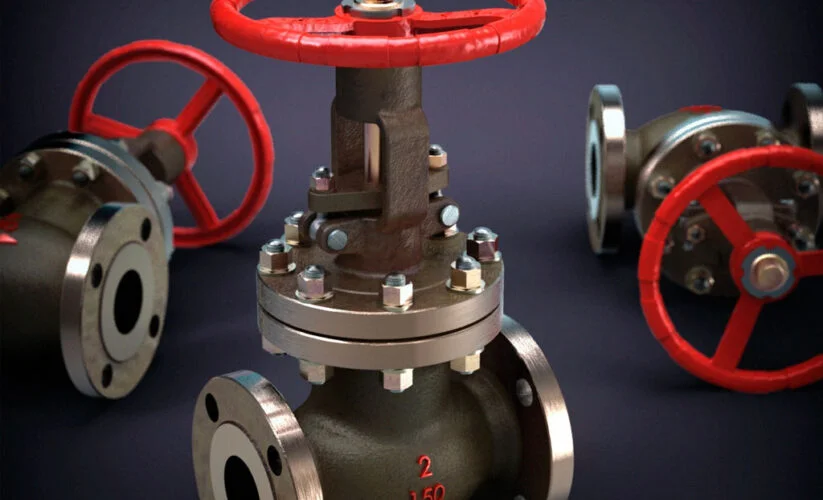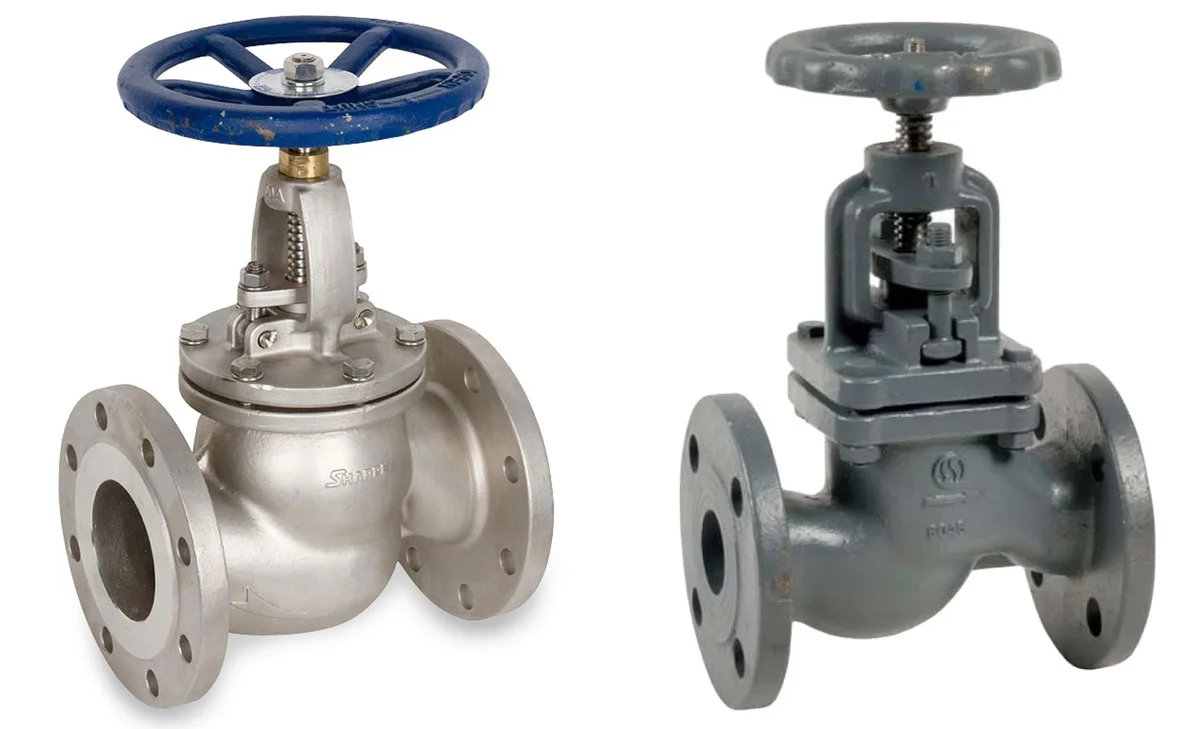What is a Globe Valve? A Comprehensive Guide

Table of Contents
ToggleIntroduction to Globe Valves
A globe valve, distinct from a ball valve, is a type of valve used for regulating flow in a pipeline. It consists of a movable plug or disc element and a stationary ring seat in a generally spherical body. Globe valves are named for their spherical body shape with the two halves of the body being separated by an internal baffle. This has an opening that forms a seat onto which a movable plug can be screwed in to close the valve. The plug is also called a disc, and it’s connected to a stem which is operated by screw action using a handwheel in manual valves.
Typically, automated globe valves use smooth stems rather than threaded and are opened and closed by an actuator assembly. Although modern valves may not have a spherical shape, the term “globe valve” is still often used for valves that have such an internal mechanism. In plumbing, valves with such a mechanism are also often called stop valves since they don’t have the spherical housing, but the term stop valve may refer to valves which are used to stop flow even when they have other mechanisms or designs.
Understanding Globe Valves: Definition and Basic Function
Globe valves are crucial components in the field of mechanical engineering and industrial applications. They are utilized to control the flow of various types of liquids or gases through a pipeline. Understanding the basic function and design of these valves is essential for engineers and technicians in diverse industries.
Anatomy
The primary components of a globe valve include a movable disk (or plug), a stationary ring seat, a bonnet, and a handwheel for operation. The disk regulates the flow by moving up or down onto the seat, thereby increasing or decreasing the flow passage.
Working Principle of Globe Valves
As the handwheel is turned, the disk moves in relation to the seat, allowing for precise control over the fluid flow. This linear motion of the disk is a distinguishing feature of these valves, distinguishing them from other types of valves.
Applications of Globe Valves
Globe valves are commonly employed in applications where flow needs to be throttled or completely shut off. Their ability to regulate flow makes them ideal for use in pipelines conveying steam, water, oil, or gas in various industries such as petrochemical, pharmaceutical, and manufacturing.
Advantages of Globe Valves
- Precise flow control
- Can be used for frequent starting and stopping
- Versatile in applications
Limitations of Globe Valves
- High pressure drop
- Slower operation compared to other valve types
- Complex design and maintenance
Globe valves play a fundamental role in industrial processes due to their ability to regulate flow accurately, making them an integral part of fluid control systems around the world.
The Key Components of a Globe Valve
Valve Body
The valve body serves as the main structure of the the valve, housing all the internal components. It is designed to withstand high pressure and temperature, ensuring the integrity of the valve under demanding operating conditions. Typically, valve bodies are constructed from durable materials such as stainless steel, carbon steel, or cast iron to provide longevity and corrosion resistance.
Bonnet
Sitting atop the valve body, the bonnet serves as a cover that encloses the moving parts of the valve, offering protection and sealing against potential leakage. The bonnet is crucial in maintaining a secure and reliable seal in high-pressure environments. It is often bolted to the valve body, creating a tight and secure seal to prevent any fluid from escaping.
Stem
Globe valve stem is a critical component responsible for controlling the flow of the fluid. When the valve is open, the stem allows the disc to move freely, enabling the regulation of flow. Typically, valve stems are designed to withstand high pressure and are sealed to prevent any leakage, ensuring efficient and reliable operation even in challenging conditions.
Disc
The disc, also known as the plug, is the component that regulates the flow of fluid within the valve. It is connected to the valve stem and moves up and down to open or close the valve. The design and material of the disc are crucial to ensure optimal flow control and sealing, enabling the valve to perform effectively and efficiently.
Seat
The valve seat is the interface where the disc comes into contact to form a tight seal, preventing any fluid from leaking when the valve is closed. The seat is often made of resilient materials such as Teflon or stainless steel, ensuring a secure closure and reliable isolation of the flow when the valve is in the closed position. A well-designed seat is essential for maintaining the integrity of the valve’s sealing capabilities.
Actuator
The actuator is the mechanism that drives the movement of the valve’s disc, either opening or closing the flow passage. It plays a vital role in automating the valve operation, allowing for remote or automatic control. Actuators can be pneumatic, electric, or hydraulic, providing flexibility in the way the globe valve is operated, depending on the specific application requirements. This component significantly enhances the efficiency and precision of the valve’s functionality, catering to diverse industrial needs.

How a Globe Valve Works
Globe valves are essential components that play a key role in controlling the flow of media in various industrial settings. Understanding how these valves work involves delving into the mechanisms of their various parts and functions.
The Role of the Stem and Handwheel
The stem and handwheel are crucial components of a globe valve, as they facilitate the opening and closing of the valve. When the handwheel is turned, it causes the stem to move either upwards or downwards, depending on the direction of the rotation. This movement controls the position of the disc, thereby regulating the flow of media through the valve.
The Movement of the Disc
The disc in a globe valve is responsible for either allowing or obstructing the flow of media. As the handwheel is operated, the stem moves the disc into or away from the seating surface. This movement alters the flow of media, allowing for precise control and regulation based on the positioning of the disc.
Sealing Mechanisms
Globe valves employ sealing mechanisms to ensure effective closure and prevent leakage. When the disc is pressed against the seating surface, it creates a secure seal that obstructs the flow of media. This sealing mechanism is crucial for maintaining the integrity of the flow control process and preventing any unintended leaks.
Understanding the interplay of these components gives insight into the intricate workings of a globe valve and its ability to provide precise control over the flow of media in industrial applications.
Types of Globe Valves
Z-body Globe Valve
Z-body globe valves are designed with a Z-shaped internal passageway, allowing for efficient flow control. They are ideal for applications requiring higher pressure and temperature conditions. With their robust design, Z-body valves are commonly used in industries such as power generation, oil and gas, and chemical processing. The distinctive shape of the valve body minimizes pressure drop, making it a preferred choice for systems where pressure loss is a concern.
Y-body Globe Valve
Y-body globe valves are characterized by their Y-shaped internal passageway, providing a straighter flow path compared to other valves. This design feature results in reduced pressure drop and turbulence, making Y-body valves suitable for applications demanding minimal resistance to fluid flow. They are often utilized in steam, air, and gas systems where precise throttling and control are essential.
Angle Globe Valve
Angle globe valves feature an angled body design, allowing the inlet and outlet ports to be positioned at a 90-degree angle. This configuration enables easier access for maintenance and repair, making these valves a practical choice for installations with space constraints. The angled construction also minimizes pressure drop and provides efficient flow control, making these valves well-suited for applications in HVAC systems, water treatment plants, and industrial processing facilities.
Advantages of Using Globe Valves
Globe valves offer several advantages that make them a popular choice in various applications. Two key advantages are precision in throttling and leak prevention.
Precision in Throttling
Globe valves provide accurate control over the flow of liquids or gases. The design of the valve allows for precise adjustments in the flow rate, making them suitable for applications that require fine-tuning of fluid or gas flow. This precision in throttling enables operators to regulate the flow with accuracy, ensuring optimal performance in different systems.
Leak Prevention
The construction of globe valves, with a disc and seat mechanism, ensures a reliable sealing capability. This design feature minimizes the risk of leakage, making these valves an ideal choice for applications where preventing fluid or gas leaks is crucial. Whether it’s in cooling water systems, fuel oil systems, or chemical feed systems, the leak prevention offered by these valves promotes efficient and safe operation.
By offering precision in throttling and effective leak prevention, globe valves prove to be valuable components in diverse industrial and commercial settings.

Common Applications for Globe Valves
Globe valves find applications across various industries due to their ability to regulate flow effectively. From flow regulation in water systems to steam control in power generation and process control in chemical industries, these valves play a crucial role in ensuring efficient and safe operations.
Flow Regulation in Water Systems
In water systems, globe valves are commonly used for flow regulation. Whether it’s controlling the flow rate in irrigation systems, adjusting water supply in commercial buildings, or managing fluid movement in municipal water treatment plants, globe valves provide precise control over the flow of water. The ability to throttle the flow makes them ideal for applications where a steady and regulated flow is essential.
Steam Control in Power Generation
In power generation facilities, steam control is vital for safe and efficient operation. Globe valves are employed to regulate the flow of steam within turbines, boilers, and other steam-driven equipment. By adjusting the valve position, operators can manage the steam flow to optimize energy production while ensuring the safety of the equipment and personnel.
Process Control in Chemical Industries
Chemical processing plants rely on globe valves for precise process control. These valves are used to manage the flow of various chemicals, including corrosive and hazardous substances. With their ability to handle high pressure and temperature conditions, globe valves contribute to maintaining the integrity of the chemical processes while enabling operators to adjust flow rates and maintain system stability.
Globe valves prove to be versatile and reliable solutions for diverse applications, offering control and efficiency across different industrial settings.













